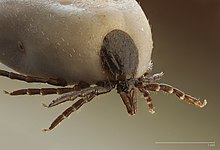Ixodidae: Difference between revisions
Appearance
Content deleted Content added
m ISBNs (Build J/) |
No edit summary |
||
| Line 16: | Line 16: | ||
==Description== |
==Description== |
||
They are distinguished from the other main family of ticks, the ''soft ticks'' ([[Argasidae]]) by the presence of a ''scutum'' or hard shield.<ref name="Cox">{{cite book |editor=Francis E. G. Cox |year=1993 |title=Modern parasitology: a textbook of parasitology |edition=2nd |publisher=[[Wiley-Blackwell]] |isbn=978-0-632-02585-5 |author=D. H. Molyneux |chapter=Vectors |pages=53–74 |url=http://books.google.co.uk/books?id=jj18axV3TTAC&pg=PA6}}</ref> Both nymphs and adults have a prominent ''capitulum'' (head) which projects forwards from the animal's body; in the Argasidae, conversely, the capitulum is concealed beneath the body. |
They are distinguished from the other main family of ticks, the ''soft ticks'' ([[Argasidae]]) by the presence of a ''scutum'' or hard shield.<ref name="Cox">{{cite book |editor=Francis E. G. Cox |year=1993 |title=Modern parasitology: a textbook of parasitology |edition=2nd |publisher=[[Wiley-Blackwell]] |isbn=978-0-632-02585-5 |author=D. H. Molyneux |chapter=Vectors |pages=53–74 |url=http://books.google.co.uk/books?id=jj18axV3TTAC&pg=PA6}}</ref> Both nymphs and adults have a prominent ''capitulum'' (head) which projects forwards from the animal's body; in the Argasidae, conversely, the capitulum is concealed beneath the body. This makes them very crush resistant, except when they are engorged and can be crushed easily. |
||
==Classification== |
==Classification== |
||
Revision as of 18:57, 28 March 2012
| Ixodidae | |
|---|---|

| |
| Ixodes ricinus (engorged) | |
| Scientific classification | |
| Kingdom: | |
| Phylum: | |
| Class: | |
| Subclass: | |
| Superorder: | |
| Order: | |
| Family: | Ixodidae C. L. Koch, 1844
|
Ixodidae is a family of ticks containing the hard ticks.
Description
They are distinguished from the other main family of ticks, the soft ticks (Argasidae) by the presence of a scutum or hard shield.[1] Both nymphs and adults have a prominent capitulum (head) which projects forwards from the animal's body; in the Argasidae, conversely, the capitulum is concealed beneath the body. This makes them very crush resistant, except when they are engorged and can be crushed easily.
Classification
There are 702 species in 14 genera,[2] some of which are of considerable economic importance as vectors of diseases such as Rickettsia and Borrelia.[1]
The family contains the following genera:[2]
- Amblyomma – 130 species (includes some of Aponomma)
- Anomalohimalaya – 3 species
- Bothriocroton – 7 species
- Cosmiomma – 1 species
- Cornupalpatum – 1 species
- Compluriscutula – 1 species
- Dermacentor – 34 species (includes Anocentor)
- Haemaphysalis – 166 species
- Hyalomma – 27 species
- Ixodes – 243 species
- Margaropus – 3 species
- Nosomma – 2 species
- Rhipicentor – 2 species
- Rhipicephalus – 82 species (includes Boophilus)
External links
References
- ^ a b D. H. Molyneux (1993). "Vectors". In Francis E. G. Cox (ed.). Modern parasitology: a textbook of parasitology (2nd ed.). Wiley-Blackwell. pp. 53–74. ISBN 978-0-632-02585-5.
- ^ a b Alberto A. Guglielmone, Richard G. Robbing, Dmitry A. Apanaskevich, Trevor N. Petney, Agustín Estrada-Peña, Ivan G. Horak, Renfu Shao & Stephen C. Barker (2010). "The Argasidae, Ixodidae and Nuttalliellidae (Acari: Ixodida) of the world: a list of valid species names" (PDF). Zootaxa. 2528: 1–28.
{{cite journal}}: CS1 maint: multiple names: authors list (link)

